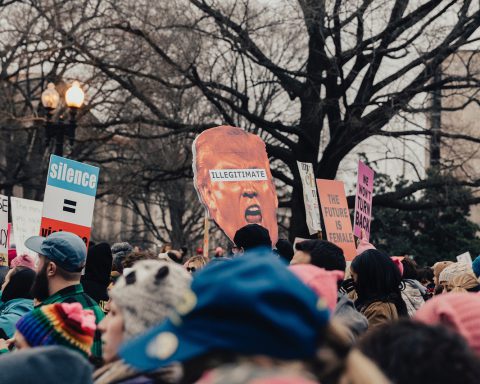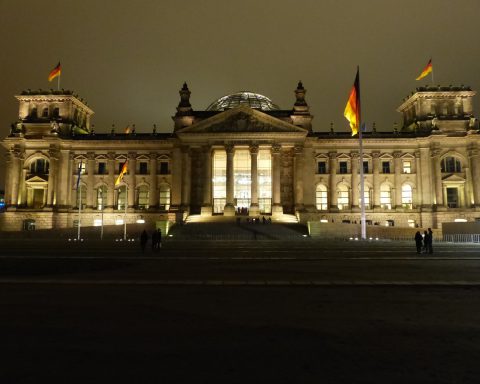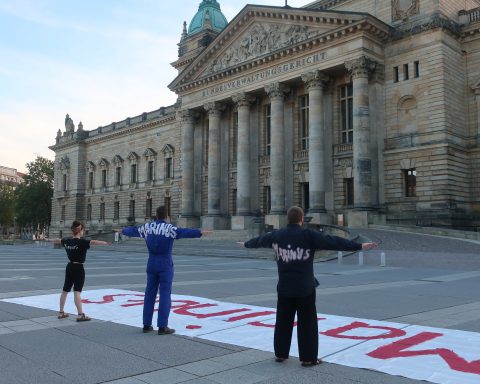I marveled at the gorgeous red mansion every time I crossed the Klinger Bridge. Particularly at the exquisitely-designed footing of the roof, with its Asian ornaments and Pagoda-like wooden beam construction. It often left me wondering: What is the history of this building? Once the light would switch to green, however, I’d move on. A second later, I had already forgotten the question the building had coaxed out of me.
I think this is very common for the places we live in.
We are surrounded by layers upon layers of history, but even if they occasionally catch our attention, we hardly ever stop to investigate.
Somehow we are always already moving on.
I was therefore excited to find out that this beautiful brick building which always caught my attention was the venue of a forum I had been invited to. Finally, here was my chance to learn all about its history!

I found out, soon after I arrived on the evening of the discussion, that it is called Villa Meyer. Leipzig publisher Herrmann Julius Meyer commissioned it in the late 19th century.
Many Germans know the blue bindings of the volumes of Meyers Konversations-Lexikon. Herrmann was the son of the encyclopedia’s founder, Joseph Meyer. Many Leipzigers know the Meyersche Häuser in Lindenau, Eutritzsch, Reudnitz, and Kleinzschocher. Herrmann founded those “Wohnkolonien” around the turn of the 20th century to provide affordable homes to Leipzigers in dire straits. The gorgeous red mansion used to be Herrmann’s home.
These days, Villa Meyer hosts Leipzig’s Club International. I got to participate in the club’s event series EnglishLounge earlier this year, along with Terron Ferguson, Hagar Lev and Jonas Kühne. We used this forum to discuss something quintessential for our engagement with the past: memory culture. After all, the past can only enter our present through memories. Yet, what is officially remembered and how it is remembered is shaped by politics.

Memory culture is always politically contested – the past is not a matter of fact, but rather a matter of debate.
Fittingly, Terron posed a somewhat provocative question for the evening: “Erinnerungskultur in Leipzig: Too Much or Not Enough?”
Hagar, an Israeli lawyer, has been working in business development for international technology companies. She started off our conversation by pointing out that her family living in Leipzig today has a lot to do with the past. It was her German roots that played a big role in their decision to relocate from Tel Aviv to Leipzig a few years back. In the meantime, Hagar has become a proud Leipziger and particularly loves that there is so much respect for the past in the city.

Jonas is a PhD candidate in history at Humboldt University, Berlin, and a board member of the Leipzig Memorial of Forced Labour. He challenged Leipzig’s record on engaging with the past. While the city has done a good job with making certain layers of its history visible to the public, it has kept others hidden. This is particularly true for the topic of forced labor in Leipzig during World War II.
At one point, 60,000 people from all over Europe were forced to work in Leipzig’s factories, mostly to produce equipment for the German army.
Jonas highlighted that this equaled 10% of Leipzig’s population at the time. After the war, this gruesome aspect of the city’s history was largely forgotten. The activists of the Leipzig Memorial of Forced Labour came together to change that. They offer walking tours through various Leipzig neighborhoods, teaching participants about forced labor sites and the people who were connected to them.
Jonas’s remarks launched us into a more general discussion about the importance of making the past visible in the places where we live. Doing so, I argued, allows us to connect with the history of these places and the people who inhabited them before us. In this regard, Hagar quoted American writer, photographer and musician Julius Lester:
History is not just facts and events. History is also a pain in the heart and we repeat history until we are able to make another’s pain in the heart our own.
An audience member shared her research into the fate of a Jewish girl who lived in her neighborhood before the Nazis came to power. In her personal correspondence, she mentioned street names and places in Markkleeberg and Leipzig that are very familiar. Placing the personal history of a former Jewish resident in a familiar environment allowed this researcher to establish a bond with this girl and her story.
This bond, she emphasized, continues into the present.

Other members in the audience had similar stories to share. After the official discussion was over, we continued our conversation in the bar area.
Participating in this edition of the EnglishLounge not only allowed me to finally learn the history of the beautiful building I had often marveled at. The conversation that evening also taught me a lot about the value of engaging with the past.
This endeavor should not be understood as merely a means of making the past knowable to us. It is also fundamental for establishing a sense of empathy for those who came before us – our neighbors in time. Whether those neighbors lived just down the street or in a spectacular mansion across the river, traces of their existence shine into our present.
If we occasionally take a minute or two to recognize their presence, to re-illuminate what time and politics have let fade, the places we inhabit become so much richer in detail, history and life.
By Richard Bachmann
Richard A. Bachmann has worked as an adjunct assistant lecturer at Leipzig University’s Institute for American Studies. He spent a year at the Holocaust Memorial Center in Detroit, Michigan, as a Service for Peace Fellow and is active in several initiatives and organizations which are concerned with memory.







